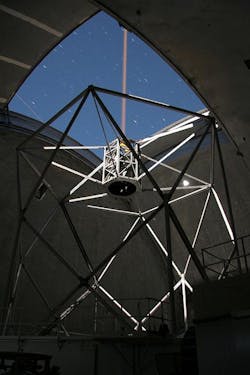Non-pulsed laser guide star funded to improve Keck II telescope AO imaging
Kamuela, HI--A new non-pulsed laser guide star system will be installed at the W. M. Keck Observatory thanks to two major grants that were awarded to help build the $4 million improved adaptive optics (AO) laser system. When installed on the current AO system on the Keck II telescope, the laser will improve the performance of the system and advance future technology initiatives. The new laser will not only be brighter, but is also a non-pulsed laser. The Keck Observatory says that researchers have discovered that non-pulsed lasers do a better job of kicking sodium atoms into action and result in a more capable and efficient guide-star laser system.
In early July the Observatory received a $1.5 million grant from the W. M. Keck Foundation, adding to a $2 million grant from the Gordon and Betty Moore Foundation awarded eight months prior for the multi-year project. Keck Observatory is charged to raise the remaining funds needed from its private supporters over the next two years.
Peter Wizinowich, who leads the adaptive optics developments at Keck Observatory, recognizes that AO systems can cancel out the distortions of the atmosphere. W. M. Keck Observatory helped pioneer the astronomical use of AO systems in the 1990s, and now delivers images three to four times sharper than the Hubble Space Telescope.
Laser Guide Star Adaptive Optics (LGS AO) use a laser beam generated from within the Observatory to excite a layer of sodium atoms 90 km above Earth. The sodium atoms are remnants of micrometeorites that have burned away as they hit the atmosphere. Once the specially-tuned laser hits these atoms, they light up and create an artificial star or beacon that can be used to precisely measure atmospheric turbulence and cancel out the distortions in real time.
The advanced Keck II laser will be blazing a trail for the adaptive optics system for use on the Thirty Meter Telescope, or TMT, currently in development. The new Keck II Laser is also one of the first steps in a $50-million Next Generation Adaptive Optics system in design at Keck Observatory that will go far beyond what is currently possible. Among the scientific breakthroughs which have come from the original Keck II LGS AO system is the definitive evidence of a supermassive black hole at the center of the Milky Way galaxy.
"Thanks to the resolving power of the Keck Telescopes, you can get the clearest view of the center of our galaxy and see the stars that are residing at its heart," said Andrea Ghez, an astronomy professor at UCLA who was recently awarded the Crafoord Prize for her research involving Keck. Ghez and her team have been observing the galactic center of the Milky Way for the last 17 years to see how these stars move. Their data helped prove the existence of the black hole, and their research is far from over. The new laser will improve their black hole research by at least a factor of two, she said.
W. M. Keck Observatory, a scientific partnership of the California Institute of Technology, the University of California and NASA, operates two 10-meter optical/infrared telescopes on the summit of Mauna Kea on the island of Hawaii. The Keck I Telescope began science observations in March 1993, and observations with Keck II began in October 1996. For more information, go to www.keckobservatory.org.
SOURCE: W. M. Keck Observatory; http://keckobservatory.org/news/1.5_million_for_next_generation_laser
IMAGE: Like the Keck I Telescope's laser, shown here, the Keck II Toptica laser will launch from behind the telescope's secondary mirror. The laser will be more powerful as well as non-pulsing, which allows it to create a brighter guide star. The guide star is used to measure starlight-bending turbulence in Earth's atmosphere that is then canceled out with a deformable mirror in the adaptive optics system. (Courtesy Andrew Cooper, W. M. Keck Observatory)
